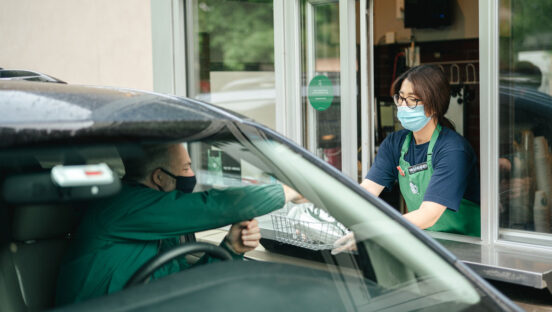A nostalgic staple of Americana, drive-in restaurants hold a special place in the hearts of millions of Americans— combining the people’s love of comfort and cars. Whether you grew up in a small town where the drive-in was the “it-place” or found yourself pulling up to a stall mid-road trip, we can all agree that the drive-in makes for a unique dining experience. First introduced in the early 1920s, shortly after the Great Influenza outbreak, drive-ins played a prominent role in the quick-service industry for roughly seventy years. However, drive-ins are few and far between and certainly don’t get the attention they deserve.
The quick-service industry recently witnessed the resiliency of the drive-in restaurant structure during the COVID-19 pandemic, likely because it originated in the years after a similar crisis. While its prominence has decreased, the American drive-in refuses to disappear completely. The demonstrated resiliency of drive-ins begs the questions: How have drive-ins managed to maintain their footing in the American quick-service market, and what does the future hold for these iconic symbols of Americana?
Drive-ins investing in more effective communication
Communication has always been an interesting facet of the drive-in experience. In the original model, customers would pull up in a parking spot, flash their headlights, and a server would soon be at their window, ready to take their order. However, order volume and throughput issues forced drive-ins to pivot. While many restaurants, like The Varsity in Atlanta, Georgia, tackled these issues by building hundreds of lanes to service the greatest number of people, many drive-ins have taken to advancing technology to help speed things up and increase capacity.
Early on, upgrades included simple button “doorbell” systems to alert the restaurant or servers on roller skates to cut down on delivery times to cars. More recently, drive-ins, like well-known and well-loved, Sonic, have implemented wireless headsets with a large connection radius so that ordering could be done faster and away from the vehicle. Today, the Sonic app allows customers to order before arriving and enjoy their meals with little to no wait time. For decades, drive-ins have had to contend with the speed and efficiency of drive-thru-centric competitors. Advanced communication technology has allowed drive-ins to service more customers at once and increase their average throughput of orders.
Drive-ins are leaning towards new tech while keeping a human touch
There is no doubt that new technology has helped keep drive-in restaurants profitable over the years, but there is something that keeps customers coming back, and that’s the human element. Giving customers a consistent and personable experience sets them apart from drive-thru competitors, who treat customers as commodities. Drive-in chains, especially mom-and-pop locations, thrive on a cultural significance and are seen as sentimental places in their towns or cities. The key to a successful drive-in is to lean into new, efficient technology without losing that human touch associated with the experience.
Although not a drive-in brand, Chick-fil-A is an excellent example of how emphasizing the human touch pays off. One of the reasons the brand became one of the fastest-growing fast-food chains only a few years after opening its doors is because of the high standards for franchisees. According to Business Insider, Chick-fil-A franchisees must complete an extensive, multi-week training program and are encouraged to run their location with a dedication to caring and compassion for their employees. Chick-fil-A outshines the competition and paves the way for drive-in brands to follow suit by basing its business model on face-to-face, friendly conversation in conjunction with portable, high-speed tablets.
Going digital while remaining nostalgic
Ironically, drive-ins have noticeably been advancing with the times. Various aspects of the model have been updated or digitized to help facilitate better throughput and customer experience. Notably, kiosk digital displays are now featured at most Sonic locations, allowing customers to interact with the digital menu at each drive-in stall. However, it’s difficult for drive-ins to utilize new technologies without jeopardizing the nostalgia they incite in customers.
With Sonic, they have made the first customer interaction digital through wireless ordering systems and offer drive-thru options. Sonic has allowed customers to choose whether they want a faster experience with less human interaction or a more traditional drive-in experience of pulling up and eating onsite in their car. For the latter, it will be vital to keep factors of the experience the same to preserve the iconicity that drive-ins thrive on. Not every mom-and-pop drive-in can afford to offer multiple options like Sonic. Still, they must carefully maintain their charm when deciding how to implement new technology into their business and what aspects of the experience to digitize.
What’s in store for the future of the American Drive-in
The resiliency of the American drive-in is apparent, and technology will likely make it easier for drive-ins to maintain their foothold in the quick-service market. While there may never be a drive-in chain the size of McDonald’s, for the foreseeable future, there will continue to be a niche market that wants to revel in the nostalgia of classic Americana.
Like vinyl records or drive-in theaters, vintage and retro things come back into style, and Americans will likely see more regional mom-and-pop drive-ins in the coming years. Their evolving relationship with technology and how it helps update the drive-in experience will be exciting. If drive-ins can balance the use of new tech with maintaining that classic iconicity, they will continue to be a viable model for emerging restaurants and brands.
Paul Crawford is the Vice President of Global Business Development at ACRELEC. He has 25 years of experience in diverse industries, including manufacturing, oil/gas, accounting, biopharmaceuticals, information technology, with a focus on the commonalities of culture, communication, technology, and leadership.











